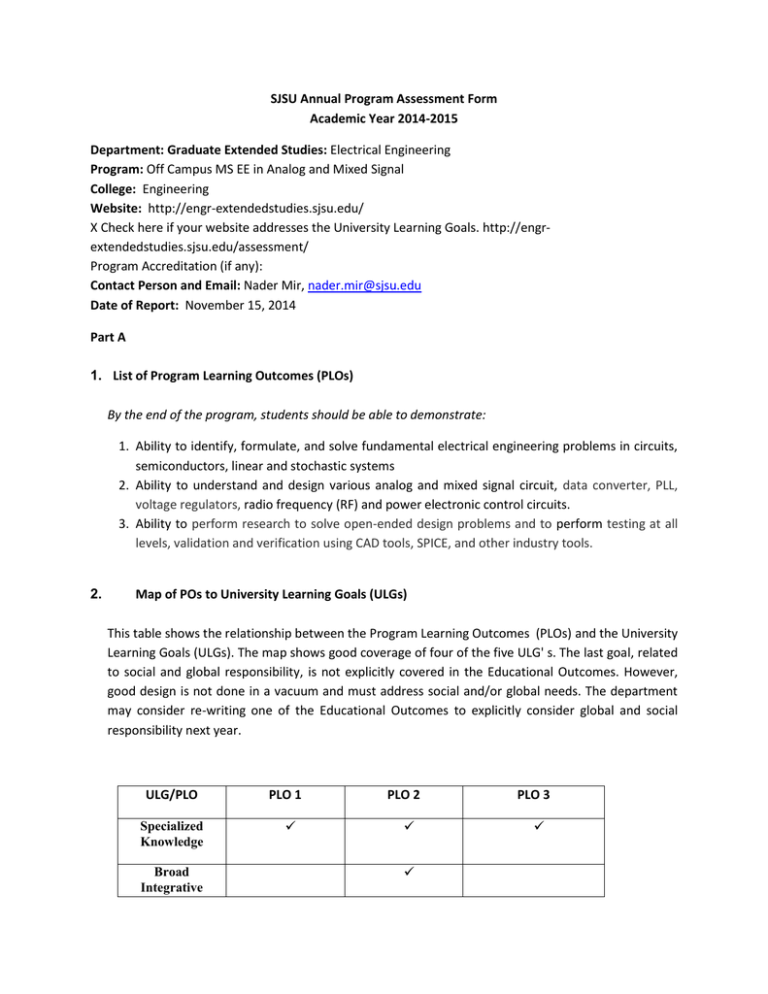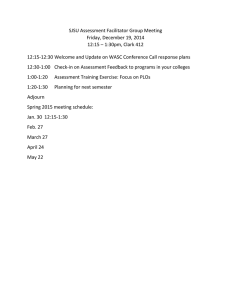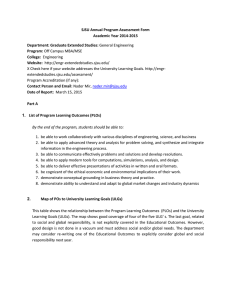SJSU Annual Program Assessment Form Academic Year 2014-2015 Department: Graduate Extended Studies: Program:
advertisement

SJSU Annual Program Assessment Form Academic Year 2014-2015 Department: Graduate Extended Studies: Electrical Engineering Program: Off Campus MS EE in Analog and Mixed Signal College: Engineering Website: http://engr-extendedstudies.sjsu.edu/ X Check here if your website addresses the University Learning Goals. http://engrextendedstudies.sjsu.edu/assessment/ Program Accreditation (if any): Contact Person and Email: Nader Mir, nader.mir@sjsu.edu Date of Report: November 15, 2014 Part A 1. List of Program Learning Outcomes (PLOs) By the end of the program, students should be able to demonstrate: 1. Ability to identify, formulate, and solve fundamental electrical engineering problems in circuits, semiconductors, linear and stochastic systems 2. Ability to understand and design various analog and mixed signal circuit, data converter, PLL, voltage regulators, radio frequency (RF) and power electronic control circuits. 3. Ability to perform research to solve open-ended design problems and to perform testing at all levels, validation and verification using CAD tools, SPICE, and other industry tools. 2. Map of POs to University Learning Goals (ULGs) This table shows the relationship between the Program Learning Outcomes (PLOs) and the University Learning Goals (ULGs). The map shows good coverage of four of the five ULG' s. The last goal, related to social and global responsibility, is not explicitly covered in the Educational Outcomes. However, good design is not done in a vacuum and must address social and/or global needs. The department may consider re-writing one of the Educational Outcomes to explicitly consider global and social responsibility next year. ULG/PLO Specialized Knowledge Broad Integrative PLO 1 PLO 2 PLO 3 Knowledge Intellectual Skills Applied Knowledge Social/Global Responsibilities 3. Alignment – Matrix of PLOs to Courses The following table provides a map of Program Learning Outcomes (PLOs) to the program’s courses. Students also take many electives. For culminating experience, students take MS project (EE 297A/B). Courses EE227 EE189A PLO1 PLO2 PLO3 EE223 EE210 EE229 EE297A EE297B Courses EE228 PLO2 PLO3 EE239 PLOs PLO1 EE221 EE250 EE220 4. Planning – Assessment Schedule Assessment data for each learning outcomes will be acquired every semester and assessed each spring. Program improvements will be implemented August 2016. The assessments are done via EE297A/B since those project courses cover all the learning outcomes. 5. Student Experience The EE MS in AMS PLOs are included on program website. Students have some knowledge of outcomes, but they are not included on most syllabi, and discussions are occasional, largely limited to the MS project/thesis courses. Feedback from alumni was incorporated into the development of the outcomes but not current students. Part B <The following items 6-9 will be provided by the IEA office by March 1 every year. The departments are welcome to obtain the data on their own, and/or to report other relevant data for their particular programs if deemed important.> 6. Graduation Rates for Total, Non URM and URM students (per program and degree) <These numbers can be obtained for your program from the IEA website at http://www.iea.sjsu.edu/ under Retention/Graduation. URM stands for Under-Represented Minorities. In some cases, the number of students who choose to report their ethnicity is too small to compute a reliable number, so please check if this is the case before interpreting. The university targets for first-time freshmen 6-yr graduation rates set by the Chancellor’s Office are 51.6%, 47.8%, and 53.2%, for total, URM and Non-URM populations, by 2015-2016. The university targets for transfer and graduate students are not specifically published, but generally improvement is expected here too. > N/A 7. Headcounts of program majors and new students (per program and degree) <The headcount of majors in your program can be found at the IEA website at http://www.iea.sjsu.edu/Assessment/ProgRev/default.cfm by major and concentration under your program name. The number of students entering your program can be found under Applied, Admitted, Enrolled on the same page. A robust and/or increasing enrollment provides evidence of demand for your program. > N/A 8. SFR and average section size (per program) <The student-to-faculty ratio (SFR) and the average headcount per section can be found at the IEA website at http://www.iea.sjsu.edu/Courses/default.cfm#Prefix under your department name. SFR and average section sizes provide some measure of cost-effectiveness and faculty load. The values can be compared to the college and/or university averages, or a comparable program at another university, if applicable. Any SFR ratios or average section sizes that are either much bigger or smaller than average should be explained and or addressed.> N/A 9. Percentage of tenured/tenure-track instructional faculty (per department) <This percentage can be calculated with information on the IEA website at http://www.iea.sjsu.edu/Faculty/default.cfm#Dept under your department name. Under Instructional Faculty - Full Time Equivalent Faculty (FTES) - by Tenure Status, the FTEF in each category is listed for each semester. Take the sum of tenured and probationary FTEF, and divide by total FTEF. In 2012, SJSU’s ratio was 53.1%, and we rank 20/23 of all of the CSUs. The highest ratios in the CSU system are 70.6%.> N/A Part C 10. Closing the Loop/Recommended Actions The following actions have been implemented in Fall 2015: Action 1: EE189 ramp course was removed from the program. Status: Competed Action 2: The program requires two core courses instead of traditional three core courses Status: Competed. Action 3: The program starts with a course other than EE229 to let students absorb the fundamentals of analog circuits Status: The program started with EE223 11. Assessment Data The assessment data were collected in the form of course learning objectives (CLOs) at the end of each course, course assessment journals (CAJs) at the end of each course, and oral interview with selected students time-to-time. For assessment of achievement of education outcomes, our attention will be made more on the MS projects and theses through. The following two table provides the description of program education objectives (PEOs) and their relationship to PLOs: Program List PEOs Educational Objectives Within five years of graduating from this program, engineers should have: PEO1 Be a practicing engineer in fields such as design, research, testing and manufacturing PEO2 Engage in lifelong learning to maintain and enhance professional skills PEO3 Fulfill the needs of society in solving technical problems using engineering principles, tools and practices, in an ethical and responsible manner PEO4 Demonstrate leadership skills in the workplace and function professionally in a globally competitive world PEOs Program Learning Outcomes PLOs PLO1 PLO2 PEO1 X PEO2 X X PEO3 X X PEO4 PLO3 X 12. Analysis <Please discuss data and evaluate achievement of PLOs and/or progress on recommended actions. Please consider the composition of your students in your interpretation, if applicable. > Data will be assessed at the end of Summer 2015 on final MS projects of AMS2 and analyzed according to PEOs. 13. Proposed changes and goals (if any) Proposal 1: Our goal is for students to take an additional elective course in AMS area. One of the recommendations is the application AMS in biomedical engineering. Proposal 2: There is a need to add a course in the area of digital to comply with partial definition of the program being “mixed signal”.


